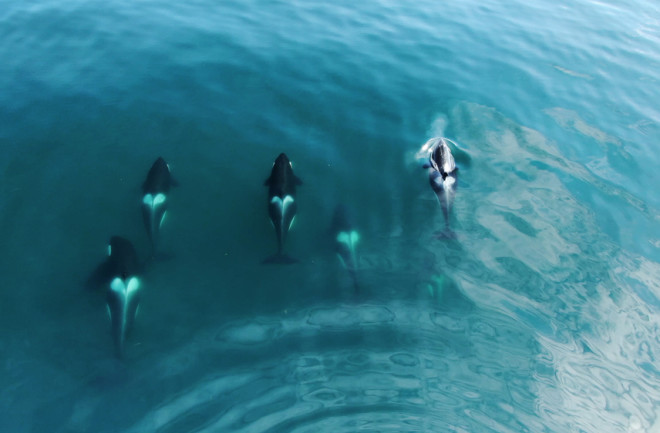In 2019, a fin whale beached itself along the Gulf of California in Mexico. The gigantic creature was so frightened by the team of orcas trying to take it down that it ran itself into the ground on the beach and later died.
While there have been only two documented instances of fin whales beaching themselves to escape killer whales, these giant mammals are being attacked more often, according to experts like Robert Pitman, a biologist who specializes in the study of killer whales at Oregon State University.
Do Killer Whales Normally Attack Fin Whales?
We don’t know for sure how often orcas attack fin whales because we still live in an era when large whales are recovering from commercial whaling. While their numbers are bouncing back, says Pitman, they aren’t where they once were, so it’s difficult to know whether this is normal behavior.
The U.S. officially outlawed whaling in 1970. Before that, in 1946, the International Whaling Commission (IWC) moved to protect whales, which had seen their numbers drop drastically as a result of whaling, a multi-million dollar industry in the 1900s. The use of other fossil fuels also became more reliable than whale oil.
As numbers of large whales plummeted, killer whales may have preyed on other things like dolphins in order to survive.
“We are starting to see killer whales attack large whales again as their numbers increase, and we may be in for some surprises,” Pitman says.
Read More: Orcas May Devour Marine Mammals, But They Typically Avoid Harming Humans
Killer Whale Hunting
As whale watching becomes more prevalent and people are able to observe them in their habitat, we’re also more likely to witness attacks. We have better cameras and drones that show us a side of killer whales that we might not have seen before.
These images show that many fin whales have signs of attacks in the form of bite marks and what are called “tooth rakes.” A study Pitman authored in the 2023 issue of Aquatic Mammals documented records of seven recent fatal attacks on fin whales, including four in British Columbia.
Read More: Instead of Hunting in Groups, Orcas May be Attacking Great White Sharks Alone
Pitman says that it’s exclusively for hunting purposes. Known as the “wolves of the sea,” killer whales hunt in packs, and as a result, they can bring down larger prey. Their hunting pods are all related, so they know each other well, which makes them better equipped to work together. But it’s not just fin whales that they go after.
They’ve even tried to chase down blue whales, though it’s much harder to bring them down because while fin whale adult females average 45 tons, blue whale adult females average a whopping 150 tons. And both of these giants are also incredibly fast swimmers.
Still, killer whales are agile hunters, says Pitman. “Pretty much anything that’s large and swims in the ocean has been shown to be prey of killer whales.” Keep in mind that different types of killer whales hunt different types of food. Some focus on fish, others on seals, and others on dolphins and whales.
Read More: Orcas Feasted on the Lips of Humpback Whales, Hunting with Ancient Whalers
Why Do Killer Whales Attack Large Whales?
According to Alisa Schulman-Janiger, lead biologist for the Killer Whale Project and a research associate for the Natural History Museum of Los Angeles, it’s all about food and socializing. One fin whale feeds a number of killer whales. An adult killer whale needs to eat about 300 pounds of meat daily, about the size of one common dolphin.
That means they have to bring down a lot of dolphins to feed their pod, while a large whale provides a lot more meat and an opportunity to get together and feast.
“It’s tougher to kill a large whale, and, in some cases, you’re not successful, but if you are successful, it’s like Thanksgiving,” says Schulman-Janiger, who co-authored the Aquatic Mammals study with Pitman.
She says they’ve seen as many as 50 killer whales come together who may not have seen each other for a long time. These could be extended families with children, parents, and grandparents who are all related. It’s like a family reunion but with a giant whale to feast on. Keep in mind that killer whales are intelligent, long-lived, and very social beings. The average male killer whale can live a maximum of 50-60 years, and females can live up to 80-90 years.
As large whales become more prevalent, killer whales are getting better at hunting them. But do not worry; these giant mammals will also likely get better at escaping. Sad as it may be, it’s the circle of life, a fascinating story from all angles.
Read More: Orcas Have Social Trends Like Us, And This One Could Get Dangerous For Boats
Article Sources
Our writers at Discovermagazine.com use peer-reviewed studies and high quality sources for our articles, and our editors review for scientific accuracy and editorial standards. Review the sources used below for this article:
Science Media Museum. A History of Whaling.
Aquatic Mammals 2023. Records of Fatal Killer Whale (Orcinus orca) Attacks on Fin Whales (Balaenoptera physalus) with an Emphasis on Baja California, Mexico.
Alaska Fish and Game. Fin Whale.
Oceana. Blue Whale.

